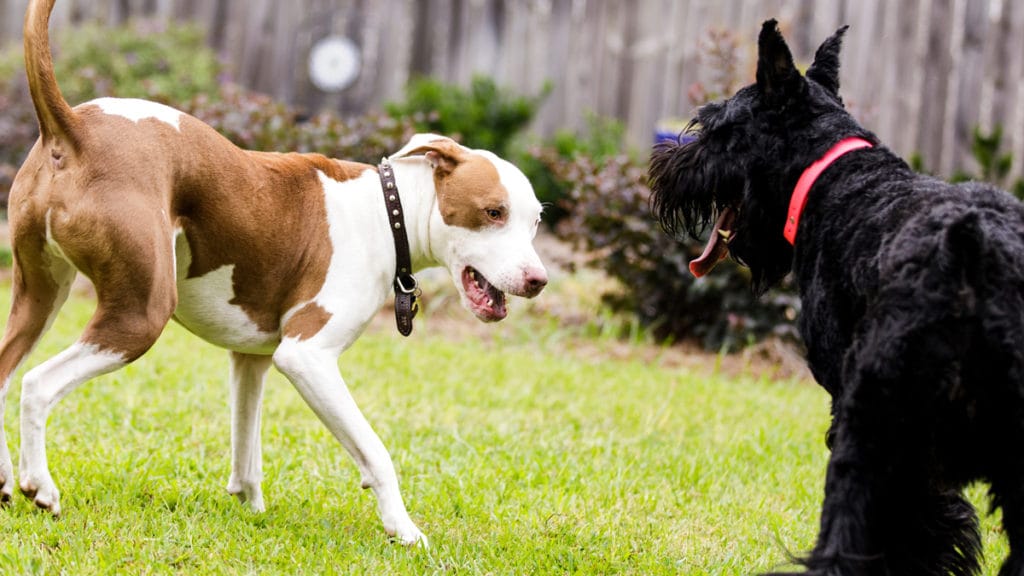If you’ve ever watched dogs playing, you know that it can sometimes be hard to recognize signs of aggression in dogs when the play seems to be too rough. “When dogs are roughhousing, it can be difficult to tell if they are having fun or actually getting a little too riled up,” says HP Parvizian, director and head trainer at Sit Means Sit Houston. “It is always important to end a play session before anything escalates.”
So, what exactly are the signs that your dog’s play session has taken a turn? Here are seven tips for recognizing signs of aggression in dogs and learning how to stop dogs from fighting, according to Parvizian.
-
Be Vigilant About Dog Aggression Towards Other Dogs
No matter where you are, it’s important to always stay vigilant of how your dog is interacting with other dogs. “It’s important to ensure that play is respectful, and that the energy of the dogs is an acceptable level,” he says. “Many dogs may continuously posture aggressively, or continue to play rough even after another dog has rolled over or is starting to look uncomfortable. This can cause a dog to go from flight mode to fight mode. If you’re ever unsure, it’s always better to err on the side of caution and redirect attention to help control the energy of the dogs at play.”
-
Implement Obedience Training to Manage Your Dog’s Energy Level
When dogs are playing and energy levels start to escalate, that could lead to dog aggression towards other dogs. As for how to stop dogs from fighting, Parvizian suggests using this as an opportunity to work on training. “Practice a recall, have your dog sit, then release them to play again,” he says. “This will allow you to practice obedience under distraction, and also help control energy before it escalates.”
Keeping your dog vigilant with his obedience is one great way to handle this, Parvizian says. For a little extra help with training, check out helpful books like Victoria Stilwell’s Train Your Dog Positively or Zak George’s Dog Training Revolution.
-
Understand Pack Dog Mentality
Especially when multiple dogs are together, another issue that might crop up is when multiple dogs are chasing or ganging up on one dog. “This pack play can be okay if they are taking turns or doing this together, one-on-one, occasionally,” says Parvizian. But remember, “While play can be fun and start off relaxed, it can escalate quickly,” says Parvizian. Occasionally you will find one dog barking and snapping at the dog that is trying to get away and looking frustrated. At this point, it’s time to intervene.
-
Don’t Second-Guess Your Instincts
If at any point you catch yourself thinking, “Let’s see what happens,” that’s a sign that play sessions could be taking a turn for the worse, says Parvizian. “Not knowing what is going to happen allows our dogs to decide if it will be a negative or positive outcome,” he adds. “It is always important to be in control and understand what we expect.”
-
Create Space for Breaks
It’s possible for appropriate play to be enjoyed by all dogs, even in a group setting or after slight aggression has been displayed, but you’ll need to build structure. To help monitor and control levels of play, you should incorporate temporary breaks—anything from a few seconds to longer, if you prefer. This gives you the opportunity to maintain appropriate energy levels and give dogs a break from the action, if needed.
-
Know Your Dog
Knowing your own dog and their body language is essential when looking for signs of aggression in dogs, says Parvizian. “When we know how our dog generally is when playing, we can know what it’s like when it’s not normal,” he says. Try to control how aggressive you let your play get at home so your dog doesn’t come to expect the same type of energy level when he’s out of the house or at the dog park.
-
Be Aware of Signs of Aggression in Dogs
Knowing what to look for when it comes to dog play behavior will help you understand if your dog is displaying signs of distress or discomfort, or if your dog is being aggressive to other dogs. For example, look for things like raised hackles (which is the hair on a dog’s back between the shoulders), quickly looking around for an escape, or constantly going under furniture to hide. “These are good examples of signs of rough play that can lead to a dog forming aggressive tendencies,” said Parvizian. If your dog is in a group play situation and is constantly trying to get away, looking nervous or stressed, or has his tail tucked while running, those are also warning signs that they are not enjoying playtime and it’s time to break it up.

Cheryl Lock is a writer and editor who lives in Denver, Colorado with her husband, daughter and cat, Penny. Her work has appeared in dozens of newspapers, magazines and websites, and she’s written about everything from pets and politics to parenting, travel and food. Find more of her work at CherylLock.com, or follow her passion for travel on her blog at WearyWanderer.com.
Share:











